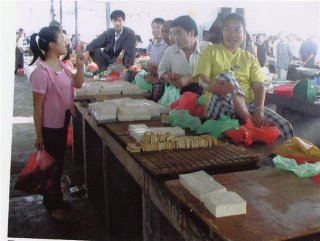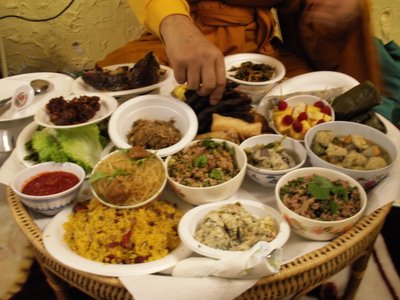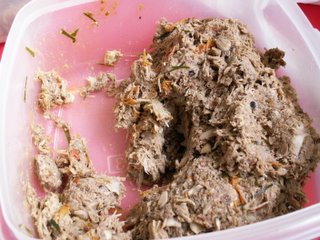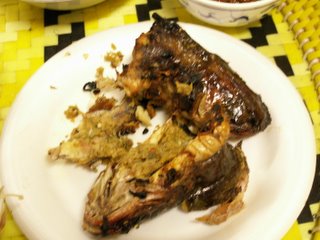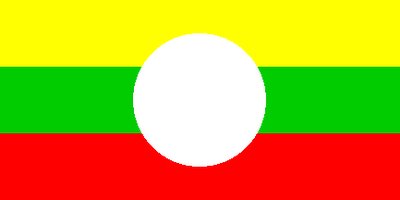The Recipe of Khao Soi Tai or Shan Khao Soi.
It is actually a noodle dish of the people of Tai Neu or theNorthern Tai near China border and also of the Tais in Sipsongpanna area,where they just call it 'Khao Soi'. They even add diced pork blood in this dish. One thing good about it is, you don't have to use 'hto nao', so youwon't have to worry about searching for hto nao. I will give you the recipe in this mail. It takes only two pages. The ingredients take up most of the space but it is really easy to make. The recipe is for about 10 servings.
Main Ingredients for Noodles:
2 packet rice noodles (flat, medium size)
4 cups ground pork or chicken (or 2 cups of each)
3 medium-size ripe tomatoes (finely cut or chopped)
1 medium-size onion (finely cut or chopped)
5 tablespoon cooking oil 1/4 teaspoon paprika
2 tablespoon thin soy sauce 1/4 teaspoon salt (or to taste)
1/4 teaspoon MSG (if desired) or sugar (if preferred)
1/2 cup water
Ingredients for Broth:
10 - 12 pieces pork bones or chicken bones
10 cups water
3/4 teaspoon salt
1/4 teaspoon MSG (if desired) or sugar (if preferred)
Ingredients for Relish and Garnishing:
1 cup pickled mustard leaves (finely cut)(hpak kaat som)
1 cup cabbage (finely cut)
1/4 sugar
1/8 teaspoon salt
1/2 teaspoon vinegar
3 blocks pickled tofu (to foo yaen)
3/4 cup water
1 tablespoon Chinese
5 spice (pakaw saakaaw)
1 cup cooking oil
1/2 cup soy sauce
1 tablespoon hot chili powder
1 cup roasted peanuts (ground into small particles)
1/2 cup finely cut spring onion (hpak mi) or coriander (hpak gi)
1 packet friend pork rind (nang pong)
PREPARATION OF BROTH
First make broth by boiling the bones in water with salt and MSG (if desired), as given in recipe for broth. Let boil for 1 hour at least (the longer it is boiled it is better because the sweet juice will be extracted more from the bones). When noodles are to be serve this broth should be boiling hot.
PREPARATION FOR NOODLES
Put noodles in a large pot, pour cold water till it covers the noodles and soak for about 1 hour. Drain noodles and set aside.
PREPARATION FOR SAUCE
Heat pot and put in oil. When oil is hot, put in onion and stir till well cooked. Add tomato, stir and let it cook till it becomes soft and pulpy. Put in ground meat, paprika, soy sauce, salt, MSG (if desired) and stir and mix well. Cover pot and cook for about 1-2 minutes. Add water and stir. Cover pot and cook for about 4-5 minutes or until there is only oil and a little water is left in the meat sauce. Shut off stove.
PREPARATION OF RELISH AND GARNISHING
1. In a bowl, mix pickled mustard leaves, cabbage, sugar and vinegar, as in making salad. Transfer the mixture on to a serving bowl.
2. Mash pickled tofu and mix and stir well in the water. Pour and keep in a container for serving. 3. Heat oil, and when hot pour half each into two small heat-proof serving containers. Put Chinese spice in one container and stir, and put hot chili powder in one container and stir.
4. Put chopped peanuts in a serving container.
5. Put soy sauce in a serving container.
6. Put chopped spring onion or corriander in a serving container.
Place these serving containers, may be each with small spoons to serve, in the middle of the dining table.
PREPARATION FOR SERVING NOODLES
Put noodles in a bowl till about 2/3 full. With a big soup ladle pour boiling broth to cover the noodles and stir and swirl well with chopsticks or a fork till the noodles are fully hot and have a soft texture. Pour back the broth into the pot by draining well. (This is what is done in the Shan State. But if preferred, boil the noodles till cooked, but not overcooked, because rice noodles cook very fast and can get very soft and break or become too soggy. Drain and keep aside until ready to use.) Spoon about 2 tablespoon of meat sauce and put in the noodle bowl. Put in as much broth as desired, a lot if you want it more watery. Put in a little of each ingredient of the relish from #2 to #6 to the noodles and mix. Taste it, and add more of whatever you want to add. Enjoy the noodles and have a bit of pork rind (nang pong) with each mouthful of noodles!
End ofrecipe.
Dear Friends,
I hope you will find the recipe not too complicating. The recipe given with hto nao is 'khao sen tai' (as per Sai Pan Hseng's mail).For khao sen you have to use very small noodles.
If you find this recipe satisfactory, please let me know. I tried to give you with easy measures, so that you won't have to look for a weighing machine. It is more or less approximate, so you can adjust the amount as you want.
Hope I have been helpful. Good Appetite! Kin waan waan kha!
hyy; gu; kor. gu; gon: kiun; yyy, myy, sungsae gam: kaa;
Sao Tern Moeng
(Letter #789, Dec 2000, from Sai Wansai's Overseas Shan Group. Below is Letter #790)
Just a little postscript to the recipe that I had given yesterday.
> > The pickle mustard and cabbage salad is to be eaten as a side dish with the noodles, so as to have something sour. If real 'pak: gaat, som;' (mon njin chin) like in the Shan State is available, it is even better (this is available in a city outside San Fransisco, made by some Shan-Chinese ladies. I don't know if they deliver their wares.) Pickled mustards are a little too salty and not to sour. All the ingredients are available in the US in Asian stores. Pickled mustard leaves comes in packets (soaked in liquid), or you can get them loosely in buckets which are sold by the pounds. Pickled tofu comes in bottles - small or large. Rice noodles, Chinese spice, are also available in Asian stores, like Thai, Cambodain, and Vietnam. Don't go to Japanese or Korean. They don't have such things, and sometimes Chinese groceries carry these items. Pork rind(nang bong:) is also available in American and Spanish groceries or snack shops.
> > With best regards,> > Sao Tern Moeng> > >


